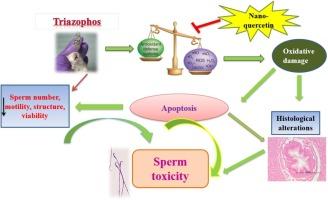Triazophos-induced spermotoxicity in rats: Protective effects of nano-quercetin
IF 4.2
1区 农林科学
Q2 BIOCHEMISTRY & MOLECULAR BIOLOGY
引用次数: 0
Abstract
This study aimed to evaluate the spermotoxic potential of triazophos in rats and to check the possible shielding effect of quercetin and nano-quercetin against triazophos-induced toxicity. Rats in Group I were given olive oil as a vehicle. Group II and Group III received high-dose and low-dose triazophos, respectively. Oral administration of quercetin (Group IV) and nano-quercetin (Group VI) at a dose of 50 mg/kg body weight was given to two additional groups of animals. Two other high-dose triazophos groups were co-administered with quercetin (Group V) and nano-quercetin (Group VII).
Triazophos administration for 60 days in rats altered the structural and functional parameters of spermatozoa and brought about a decline in total sperm count, percentage of viable sperms, drop in sperm motility, and decrease in the number of sperms showing normal morphology. It also decreased the number of spermatozoa with intact acrosomes and HOST-positive spermatozoa. Further, triazophos increased the levels of reactive oxygen species and triggered apoptotic pathways in spermatozoa in a dose-dependent manner. It decreased daily sperm production and caused histomorphological aberrations in the epididymis and vas deferens. Co-administration of nano-quercetin with triazophos effectively counteracted sperm-related pathological changes. Nano-quercetin offered better protection over quercetin in ameliorating the triazophos-induced spermotoxicity in rats.

三唑磷诱导的大鼠精子毒性:纳米槲皮素的保护作用
本研究旨在评估三唑磷对大鼠精子的潜在毒性,并检测槲皮素和纳米槲皮素对三唑磷诱导的毒性可能产生的保护作用。I 组大鼠服用橄榄油作为载体。第二组和第三组分别接受高剂量和低剂量三唑磷。另外两组动物口服槲皮素(第四组)和纳米槲皮素(第六组),剂量为每公斤体重 50 毫克。给大鼠服用三唑磷 60 天,会改变精子的结构和功能参数,导致精子总数、存活精子百分比、精子活力下降,以及形态正常的精子数量减少。它还会减少具有完整顶体和 HOST 阳性精子的数量。此外,三唑磷还会增加活性氧的水平,并以剂量依赖的方式引发精子凋亡。三唑磷会降低精子的日产量,并导致附睾和输精管组织形态畸变。同时服用纳米槲皮素和三唑磷可有效抵消与精子相关的病理变化。在改善三唑磷诱导的大鼠精子毒性方面,纳米槲皮素比槲皮素具有更好的保护作用。
本文章由计算机程序翻译,如有差异,请以英文原文为准。
求助全文
约1分钟内获得全文
求助全文
来源期刊
CiteScore
7.00
自引率
8.50%
发文量
238
审稿时长
4.2 months
期刊介绍:
Pesticide Biochemistry and Physiology publishes original scientific articles pertaining to the mode of action of plant protection agents such as insecticides, fungicides, herbicides, and similar compounds, including nonlethal pest control agents, biosynthesis of pheromones, hormones, and plant resistance agents. Manuscripts may include a biochemical, physiological, or molecular study for an understanding of comparative toxicology or selective toxicity of both target and nontarget organisms. Particular interest will be given to studies on the molecular biology of pest control, toxicology, and pesticide resistance.
Research Areas Emphasized Include the Biochemistry and Physiology of:
• Comparative toxicity
• Mode of action
• Pathophysiology
• Plant growth regulators
• Resistance
• Other effects of pesticides on both parasites and hosts.

 求助内容:
求助内容: 应助结果提醒方式:
应助结果提醒方式:


